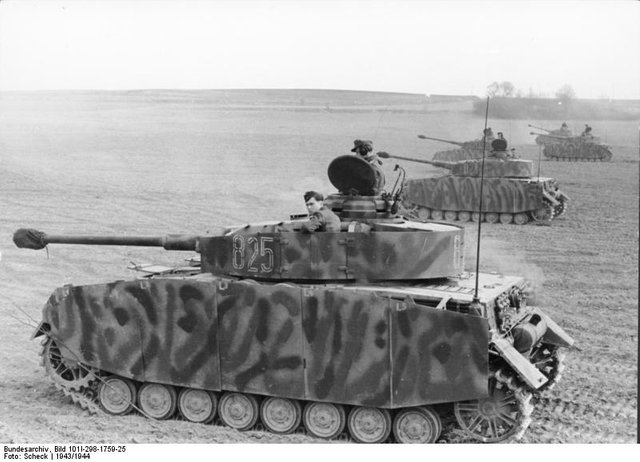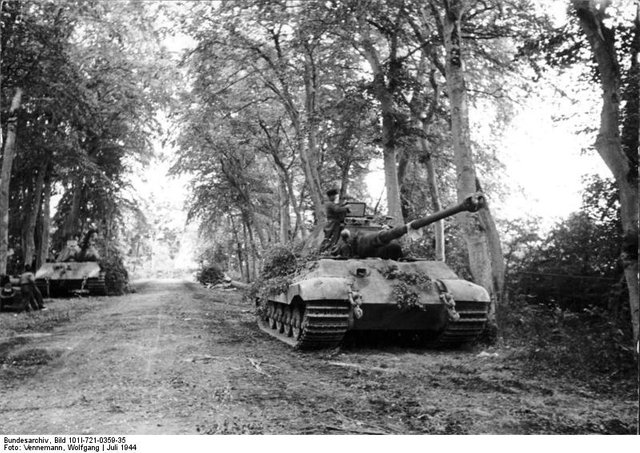Panzer Terror - Debunking the Myth of German Armoured Superiority
It is often said that, during the Second World War, responsibility for the German victories lay in large measure to the superiority of their incredible and technologically advanced Panzers. This is a myth, further than that, it is an excuse for Allied (particularly French & British) military failure that has long passed its sell by date.
The Early War, 1939-41 the years of Victory.

In this period German Panzers stomped on just about anything that they faced. The only real setback they had was against the British 1st Army Tank Brigade at Arras in 1940, where the 88mm Flak 18 demonstrated its prowess as an anti-tank gun. In those early years of the conflict Germany had on strength 4 main types of Panzer: the Pzkpfw I, a two seat, machinegun armed light tank only ever intended for training, Pzkpfw II, three seat light tank produced as a stopgap until honest to goodness battle tanks were available, the Pzkpfw III, a real battle tank as good as anything available to all the contemporary armies and the Pzkpfw IV, a larger support tank that was still very capable in tank against tank combat. There were also two types of Czechoslovakian lights tanks available: the the Praga LT-35, a capable tank, if not truly the equal of the Pzkpfw III and the Praga LT-38, an excellent Czech machine is capable as anything else available at the time. The issue for the German Armed Forces at this point in time was that of the most numerous tank in service was the lowly Pzkpfw II with its small 20 mm gun and thin armour, nor was the Pzkpfw I in service in inconsequential numbers. At the time of Germany's greatest successes the backbone of the Panzer arm was made up of light tanks with little armour and poor striking power.
The Mid-War Years, 1942-43 Hitler takes over.

The Mid-War period was a time of more balanced battles for the German Panzer arm. Despite the phasing out of the light tanks and better versions of the Pzkpfw III & IV serving in the Panzer divisions, the days of easy victories were gone. By the end of 1941 all of the great game changes had occurred, the Wehrmacht had made acquaintance with the Soviet T-34 in KV Tanks, Britain was secure in its island fastness, America had joined the war and Adolf Hitler had taken strategic control of the war into his own hands. Each one of these events was a disaster in of itself, together they were the writing on the wall. Coming into contact with tanks such as the British Matilda II and the Soviet T-34 led the Germans to install ever larger guns in their tanks and failing that, to construct tank destroyers and obsolete or captured hulls in order to carry these larger weapons into action. At first it was the logical progression of adding larger, more efficient guns to the Pzkpfw III & IV, but Hitler demanded a vehicle mounting an even larger weapon, the famed 88mm & and so the tiger was born and on the crest of that hill was found the slippery slope to insanity.
Ferdinand Porsche initially wanted to create an advanced Tiger using an technologically advanced electrical drive system. This however was ahead of its time and never truly worked properly, the few that were built were converted into Ferdinand tank destroyers, mountain even more powerful 88mm gun than was carried by the tiger itself. And therein lies the problem of the later, incredibly powerful and well protected German tanks, they were too complex. The two great advances for German army during this period, the Tiger and the Panther first saw service during operation Citadel, the attack at Kursk in July 1943. Both vehicles were well capable of destroying any Soviet vehicle in service, with armour that offered excellent protection in combat. On the downside both vehicles were complex, difficult to build and, in their early days, prone to mechanical failure.
The Late War, 1944-45 The End.

In the last two years of the war the German army was in constant retreat, hard fought battles against poor odds were the losses that could never be replaced. Hitler's scientists drew up plans for numerous wonder weapons, some of which actually worked, but many were the best pie in the sky and at worst deliberate fraud. Of those vehicles only one tank actually made it into service in any numbers, the King Tiger. This was a monster of a tank, very technologically advanced, mounting the same gun that the Ferdinand tank destroyer had carried and with thick sloping armour that offered protection against virtually all threats. This was almost certainly the most powerful tank of the Second World War and yet, it cannot really be described as a success. Hitler was obsessed with creating ever larger, more powerful tanks, vehicles like the Pzkpfw VIII Maus (1 built), a 200 ton monster with a huge 128mm anti-tank gun and the Landkreuzer P.1000 Ratte (never left the drawing board) a huge, 1,000 ton monstrosity with a battleship turret.
Conclusions
The historical record clearly shows that as German armoured fighting vehicles improved, German victories decreased. The German Armed Forces performed better during the Second World War with poor equipment than they did with a clear technological superiority. In direct head to head combat, it was sad that it took four Shermans the kill a Tiger, but with around 40 Shermans produced for every Tiger it was a poor exchange rate. The production disparity for the T-34 was even worse for Germany with the T-34 being produced in greater numbers that all German tanks combined. Small numbers of technologically advanced tanks can't hope to defeat large numbers of tanks that are merely good.
When Heinz Guderian spoke of armoured forces, he used the word "stosskraft" to describe the dynamic punch that can be delivered by properly organised armoured forces. Guderian, Rommel and others use these techniques to use armour at its most effective, even when their forces were at their most limited. Once politics had replaced generalship in the driving seat of the Wehrmacht, the equation changed for the worse. The quality of the machine can never replace the quality of the man who is making use of that machine, be it a simple bolt action rifle or a Panzer division with thousands of men and hundreds of tanks. This in negative situation was compounded by the lack of production of German tanks which was again compounded by the complexity of those same advanced vehicles. The fact of the matter is quite simply that Germany defeated all comers despite the majority of its tanks being of poor quality and lost because its technologically advanced tanks were available in too few numbers to make a difference.
Bibliography
History of the Second World War - Winston S. Churchill,
Panzer Leader - Heinz Guderian,
Achtung Panzer - Heinz Guderian,
History of the Second World War - Basil Liddel Hart,
Panzer Commander - Hanz Von Luck
Tank Versus Tank - Kenneth Macksey
France 1940 - Alan Shepperd
A New Excalibur - A. J. Smithers
Germany and a Lightening War - Fritz Sternberg,
Links to Wikipedia Articles on the various tanks for clarity on technical matters and still remaining concise.
Imaged from Wikimedia Commons & Bundesarchiv

Brilliant piece of information from the History !!!
The world has absolutely changes now, in terms of technological advancements and tactical warfare!!!
Thanks for the interest. I see today that while technology is more advanced, if not radically different, but the lesson is still the same.